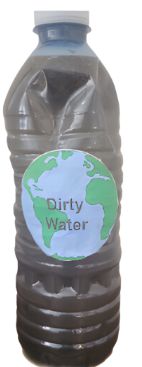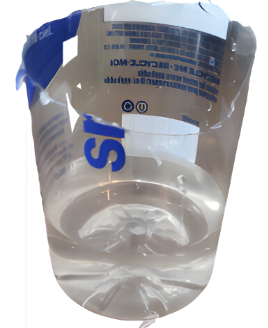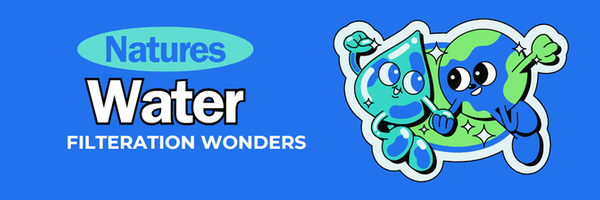Nature's Water Filtration Wonders
Grade 5
Presentation
Hypothesis
Natural resources (such as Pebbles, Sand, Gravel, Charcoal, and Dolomite) can filter contaminated water (Alternate Hypothesis). On the other hand, natural resources (such as Pebbles, Sand, Gravel, Charcoal, and Dolomite) can not filter contaminated water (Null Hypothesis).
Research
Types of Water Contaminants
- Dirt and Mud:
- Imagine playing in the mud – it's fun, but we don't want that mud in our water. Dirt and mud are like little bits of earth that can make water look yucky.
- Bacteria and Germs:
- Picture tiny invisible creatures. Some are good, but others can make us sick. Bacteria and germs are like these tiny creatures that can hide in water and make it not safe to drink.
- Leaves and Twigs:
- Think about the leaves and twigs we find outside. Sometimes, these things can get into water and make it messy.
- Chemicals:
- Imagine colorful liquids like the ones you see in a science kit. Sometimes, chemicals from factories or homes can mix with water and make it not good for us.
- Trash:
- Think about wrappers, plastic, or anything we throw away. If these things end up in water, it can make the water look dirty and harm the animals living in it.
- Oil and Grease:
- Picture the oily stuff when we cook – like when we make pancakes. If oil and grease get into water, they create a film on top, and fish and other water friends might not like it.
- Soap and Detergents:
- Imagine the bubbles when you take a bath. Sometimes, the soap we use can end up in water, and too much of it can make water not good for the creatures living there.
Safety Precautions
- Cool Materials Only!
- I’m using cool stuff like cotton, sand, gravel,charcoal, dolomite, and pebbles. Remember, these are for our water experiment, not for eating or playing. Keep them away from your mouth!
- Team Up with Grown-Ups!
- Sometimes experiments need a bit of grown-up help. Ask a parent or teacher to assist with anything tricky or if you need extra hands. Teamwork is awesome!
- Wash Those Hands!
- Before we start, let's wash our hands. Clean hands make for a happy and healthy experiment. Rub-a-dub-dub!
- No Tasting, Just Testing!
- Our water cleaner is for testing, not tasting. Don't drink or taste anything from the experiment. Safety rule: Keep experiment stuff out of your mouth!
- Splash-Free Zone!
- We want to keep the experiment on the table. No splashing allowed! Safety goggles? Not this time, but keep your eyes safe and dry.
- Clean-Up Heroes!
- After the fun, it's clean-up time! Tidy up your experiment area and wash your hands again. Clean space, happy face!
- Report Anything Strange!
- If something seems off or strange during the experiment, tell a grown-up or your teacher. We want to make sure everything is safe and fun!
Photograph of the Results
Today, I explored natural resources in filtering yucky water. I made a big guess (hypothesis) about what would happen. I used various affordable materials and put together a puzzle for clean water! With notes and pictures, I tracked the experiment, and guess what? The water went from yucky to clean – my water filter did an amazing job! Check out these pictures – on the left is the water before, and on the right is after filtering the dirt. It’s cool, right?


Boiling water
The natural resources filtered the water but did not make it safe to drink. Boiling your water is 100% purified. It is the surest way to kill germs and make water healthier to use. It is advisable to boil the water to make it safe to drink. Some people add a pinch of salt to the water in order to increase the boiling point.
Facts to reduce water pollution
- Use Less Plastic:
- Choose reusable stuff to cut down on plastic waste.
- Trash Goes in Bins:
- Put trash in the right bins to keep it out of water.
- Careful with Chemicals:
- Use less stuff with chemicals to keep water clean.
- Plant Trees:
- Trees help keep water clean, so plant them!
- Clean Up After Pets:
- Pick up pet poop to stop it from get into the water.
- Help Clean Up:
- Join cleanups to remove trash from water places.
- Save Water:
- Use water carefully at home to keep it clean.
- Tell Everyone:
- Share what you know about keeping water clean with friends!
Variables
Independent variable
Natural resources ( Pebbles, Sand, Gravel, Charcoal, and Dolomite)
Dependant variable
Filtration effectiveness
Procedure
- Prepare all Materials
-
Label the bottle
-
Set up station
-
Pour water through the filter
-
Watch and Write
-
Put it in slides/logbook
-
Compare before and after results
-
Take pictures
-
Stay Safe
-
Have Fun
Observations
- Water Clearness: I checked if the water looks cleaner after using the filter.
- Color: I tried to notice if the water changes color after filtration, becoming less dirty or cloudy.
- Smell: I determined if the water smells better or worse after passing through the filter.
- Particles: I looked for any visible bits or particles in the water before and after filtration to see if the filter removes them.
- Cost and Materials: I also considered how much the materials for the filter cost and if they are easy to find.
- Environmental Impact: And I thought about whether using the filter is good or bad for the environment and if it creates any waste.
- Durability: And lastly I tested how long the filter lasts before it needs to be replaced or fixed.
Analysis
First you cut a hole through the 1 litre bottle with your scissors. Then you flip one side and place them together. Then you add some cotton to hold everything together. After you put sand over the cotton. Sand captures the dirt as the dirty water flows through the sand. Next you put charcoal. Charcoal is a helpful companion in the filter, removing toxins while preserving essential minerals. Then you pour the gravel. The gravel acts as a bumpy road, catching large particles. Next you dump in dolomite. The dolomite functions like a superhero rock, eliminating silica to ensure water safety. And finally you put pebbles, the pebbles create a strong barrier forming a fence that blocks big dirt.
Conclusion
Clean water is super important! We all need it to live and stay healthy. Turning yucky water into clean water was so much fun, and I learned a lot. In answering the question in slide 5 “to what extent can natural resources filter contaminated water”, I will say natural resources filter contaminated water, making it clean but not safe to drink. So, let's talk about boiling water!
Application
Now that we know how awesome clean water is, let's do something fun! We can tell our friends and family what we learned, and maybe they'll think it's cool too. Try making a water filter at home with things you find in your garden. It's like your very own science experiment! Also, think about how we use water every day and try not to waste it. Turning off taps when we're not using them and fixing leaks can help a lot. What if we did something cool in our neighborhood to teach others about clean water? Even small things we do can make a big difference. So, let's all do something fun and make a splash for cleaner, healthier water together!
Sources Of Error
My experiment continuously spilled and leaked, so I just put a lid on it. My water was also not coming out clear at first because I forgot to wash the materials, so I just kept on pouring the dirty water through the filter so as the water went through, it would also be cleaning the water.
Citations
- https://www.britannica.com/science/water-pollution
- https://slidesgo.com/theme/action-plan-for-water-pollution-prevention#search-water+pollution+prevention&position-1&results-2&rs=search
- https://www.nrdc.org/stories/water-pollution-everything-you-need-know
- https://www.nationalgeographic.com/environment/article/freshwater-pollution
- https://royalbrinkman.com/knowledge-center/technical-projects/water-filter-technologies-horticulture/sand-filter#:~:text=A%20sand%20filter%2C%20or%20sand,fine%20pores%20of%20the%20sand.
- https://www.quora.com/How-can-pebbles-help-in-filtering-water#:~:text=Pebbles%20can%20help%20in%20filtering,cleaner%20water%20to%20pass%20through.
- https://www.calcinor.com/en/news/product-reviews/the-functions-of-lime-in-water-treatment#:~:text=Calcined%20dolomite%20(CaO%20MgO)%2C,for%20the%20elimination%20of%20silica.
- https://letstalkscience.ca/educational-resources/hands-on-activities/what-are-best-materials-use-cleaning-water#:~:text=Sand%20and%20gravel%20make%20good,the%20dirt%20particles%20get%20trapped.
- https://www.wfa.com.au/charcoal-water/#:~:text=Adsorption%20binds%20impurities%20chemically%20on,of%20salts%20and%20important%20minerals.
Acknowledgement
I want to acknowledge gratitude to Mrs. Contractor for her incredible support and guidance throughout this project. And to my mom for helping me gather all the materials I needed. I also want to thank my classmates for their support, feedback, and for making this project so much fun! Your encouragement meant the world to me.

